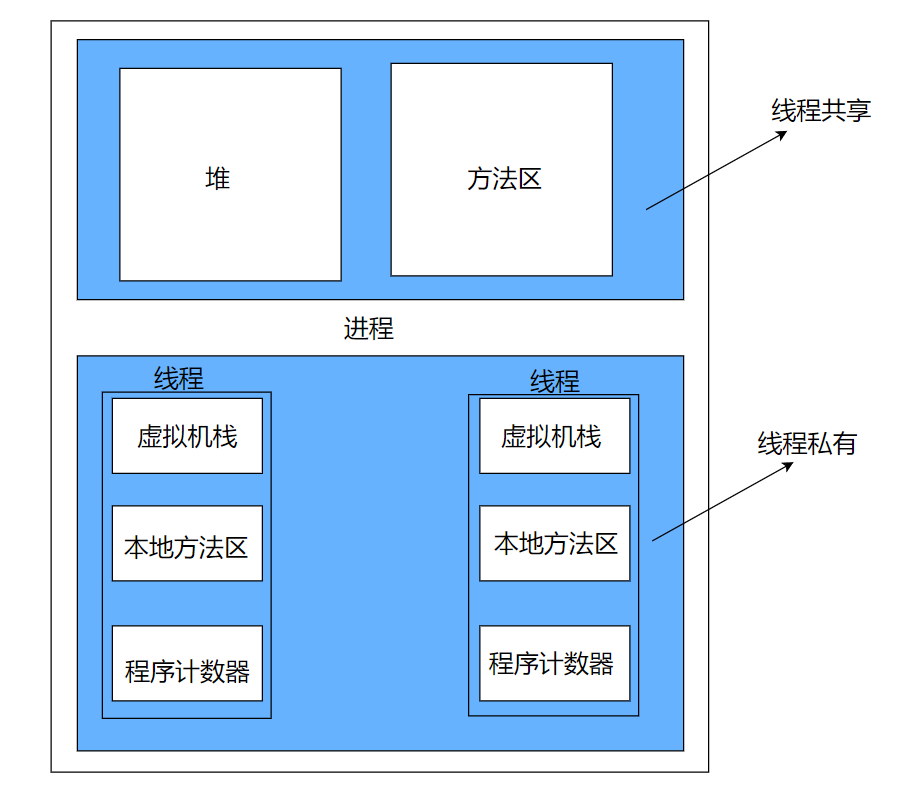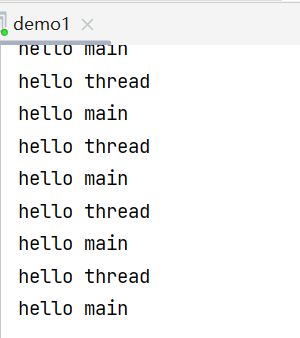文章目录
✍线程是什么?✍线程和进程的区别✍线程的创建1.继承 Thread 类2.实现Runnable接口3.匿名内部类4.匿名内部类创建 Runnable ⼦类对象5.lambda 表达式创建 Runnable ⼦类对象
✍线程是什么?
⼀个线程就是⼀个 “执行流”. 每个线程之间都可以按照顺序执行自己的代码. 多个线程之间 “同时” 执⾏着多份代码.
✍线程和进程的区别
进程是包含线程的. 每个进程⾄少有⼀个线程存在,即主线程进程和进程之间不共享内存空间. 同⼀个进程的线程之间共享同⼀个内存空间.进程是系统分配资源的最⼩单位,线程是系统调度的最⼩单位。⼀个进程挂了⼀般不会影响到其他进程. 但是⼀个线程挂了, 可能把同进程内的其他线程⼀起带⾛(整个进程崩溃).进程中的一个执行任务(控制单元),负责当前进程中程序的执行。一个进程至少有一个线程,一个进程可以运行多个线程,多个线程可共享数据。
与进程不同的是同类的多个线程共享进程的堆和方法区资源,但每个线程有自己的程序计数器、虚拟机栈和本地方法栈,所以系统在产生一个线程,或是在各个线程之间作切换工作时,负担要比进程小得多,也正因为如此,线程也被称为轻量级进程
为什么虚拟机栈,本地方法区,程序计数器是私有的?
程序计数器
和PCB中的上下文联系起来:
在上文中,我们提到“并发执行”,在执行过程中,会产生很多的“中间结果”,在进程切出于CPU之前,需要把这些“中间结果”(CPU的寄存器中的各种值),保存到PCB的上下文中。
这个过程是将寄存器的数据存放到内存中,也就是我们平时所见的【存档】
当下一次CPU再次调度这个进程时,就要把之前的数据读取出来,放入寄存器中,也就是所谓的【读档】。
具体操作过程:有一个PC程序计数器,他会记录上一次执行到哪一个位置,在下一次执行时,就从这个位置继续执行。
虚拟机栈:每个 Java 方法在执行的同时会创建一个栈帧用于存储局部变量表、操作数栈、常量池引用等信息。从方法调用直至执行完成的过程,就对应着一个栈帧在 Java 虚拟机栈中入栈和出栈的过程。
本地方法栈:和虚拟机栈所发挥的作用非常相似,区别是: 虚拟机栈为虚拟机执行 Java 方法 (也就是字节码)服务,而本地方法栈则为虚拟机使用到的 Native 方法服务。 在 HotSpot 虚拟机中和 Java 虚拟机栈合二为一。
✍线程的创建
1.继承 Thread 类
class MyThread extends Thread{ @Override public void run() { while (true){ System.out.println("hello thread"); try { Thread.sleep(1000); } catch (InterruptedException e) { throw new RuntimeException(e); } } }}public class demo1 { public static void main(String[] args) throws InterruptedException { Thread t = new MyThread(); t.start(); while (true){ System.out.println("hello main"); Thread.sleep(1000); } }}2.实现Runnable接口
class MyRunnable implements Runnable{ @Override public void run() { while (true){ System.out.println("hello thread2"); try { Thread.sleep(1000); } catch (InterruptedException e) { throw new RuntimeException(e); } } }}public class demo2 { public static void main(String[] args) throws InterruptedException { Thread t = new Thread(new MyRunnable()); t.start(); while (true){ System.out.println("hello main2"); Thread.sleep(1000); } }}3.匿名内部类
public class demo3 { public static void main(String[] args) throws InterruptedException { Thread t = new Thread(){ @Override public void run() { while (true){ System.out.println("hello thread3"); try { Thread.sleep(1000); } catch (InterruptedException e) { throw new RuntimeException(e); } } } }; t.start(); while (true){ System.out.println(" hello main"); Thread.sleep(1000); } }}4.匿名内部类创建 Runnable ⼦类对象
public class demo4 { public static void main(String[] args) throws InterruptedException { Thread t = new Thread((Runnable) () ->{ while (true){ System.out.println("hello thread4"); try { Thread.sleep(1000); } catch (InterruptedException e) { throw new RuntimeException(e); } } }); t.start(); while (true){ System.out.println(" hello main4"); Thread.sleep(1000); } }}5.lambda 表达式创建 Runnable ⼦类对象
public class demo5 { public static void main(String[] args) { Thread t = new Thread(()->{ while (true){ System.out.println("hello thred5"); try { Thread.sleep(1000); } catch (InterruptedException e) { throw new RuntimeException(e); } } }); t.start(); while (true){ System.out.println(" hello main5"); try { Thread.sleep(1000); } catch (InterruptedException e) { throw new RuntimeException(e); } } }}运行结果为两个线程交替执行。
由于没有终止条件,这两个线程会一直执行下去。